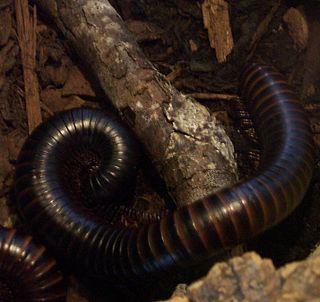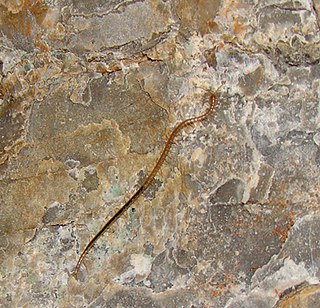
Lithobius is a large genus of centipedes in the family Lithobiidae, commonly called stone centipedes, common centipedes or brown centipedes.
Anastreptus is a genus of giant African millipedes in family Spirostreptidae, containing five species:

Spirostreptus is a genus of giant millipedes of the family Spirostreptidae. It contains the following species:

Orthoporus is a genus of spirostreptid millipedes, containing around 80 species, distributed from the southern United States to Brazil and Argentina.

Zephroniidae is a family of giant pill millipedes in the taxonomic order Sphaerotheriida. They occur in southeast Asia from the Himalayas and China south and east to Sulawesi and to Australia, and also inhabit some Philippine islands.
Anethoporus is a genus of spirostreptid millipedes native to northern South America, where they range from Peru to the islands of Trinidad and Tobago. The genus and type species, A. clarki, was established by Ralph V. Chamberlin in 1918.

Geophilus is a large, heterogeneous genus of soil centipedes in the family Geophilidae largely considered to be synonymous with Brachygeophilus. The generic name first appeared in Brewster's Edinburgh Encyclopaedia in 1814 as Geophilus electricus. This genus has a Holarctic distribution.
Akamptogonus is a genus of flat-backed millipedes in the family Paradoxosomatidae. There are about 11 described species in Akamptogonus.

Trigoniulus is a genus of millipede in the family Trigoniulidae. There are at least 90 described species in Trigoniulus.
Catharosoma is a genus of millipedes belonging to the family Paradoxosomatidae.
Siphonophora is a genus of millipedes belonging to the family Siphonophoridae.

Cryptops sometimes known as cave centipedes, is a centipede genus in the family Cryptopidae; species records have a world-wide distribution.

Otostigmus is a genus of centipedes in the family Scolopendridae. It was first described by Swedish naturalist Carl Oscar von Porat in 1876. The genus as a whole comprises around 157 species, found primarily in the Neotropics.

Ribautia is a genus of centipedes in the family Geophilidae. This genus was described by French myriapodologist Henry Wilfred Brolemann in 1909. Centipedes in this genus are found in South America, tropical Africa, Madagascar, the Arabian peninsula, Australia, New Zealand, and Melanesia.
Tuoba is a genus of 17 species of centipedes, in the family Geophilidae. This genus was described by American biologist Ralph Vary Chamberlin in 1920. These centipedes are found in coastal regions and islands in the Mediterranean and in the Atlantic, Pacific, and Indian oceans.
Mecistocephalus is a genus of centipedes in the family Mecistocephalidae. It was described by British entomologist George Newport in 1843.

Lamyctes is a genus of centipedes in the family Henicopidae. It was described by Danish entomologist Frederik Vilhelm August Meinert in 1868.

Australobius is a genus of centipedes in the family Lithobiidae. It was described by American biologist Ralph Vary Chamberlin in 1920.

Otostigminae is a large subfamily of centipedes, containing nearly half of all species in the family Scolopendridae. Members of this subfamily are abundant and widespread throughout the tropical and subtropical regions of the world, mostly in Africa, Asia, and Australia.
Schendylops is the largest genus of centipedes in the family Schendylidae, containing more than 60 species. This genus was first proposed by the American biologist Orator F. Cook in 1899 for the type species originally named Schendyla grandidieri in 1897. Most species in this genus are found in the Neotropical region, but a dozen species are found in Africa and Madagascar. These species live in diverse habitats, ranging from sea level to high altitudes.











